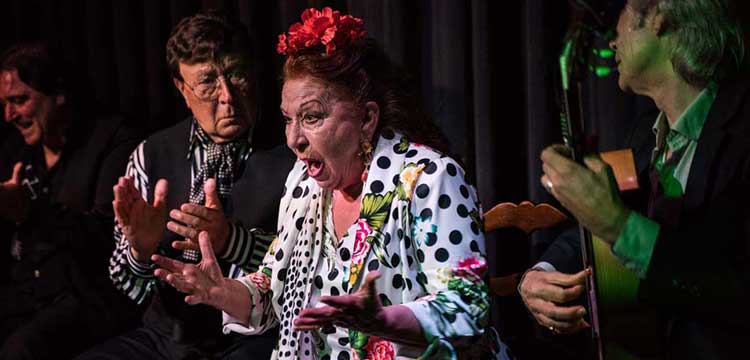“See it to believe it”
La Cañeta de Málaga offered an intense recital full of essence at the Sala García Lorca
José Manuel Gómez Gufi
Back at the Sala García Lorca (Casa Patas), you reencounter those flamenco militants of a style, like apostles, announcing happy news or absolute truths, take your pick. They’re flamenco fans, a group of people who defend the art from the heart of the art-form. People who defend their way of hearing in a legitimate way. And in this way, you’re again surprised by the prodigy of humans able to create art with a voice and a bunch of strings attached to a few pieces of wood.
Just like that, with no amplification, unplugged. With no sound check! The artists depend on the audience’s help, people who offer silence and knowledge. Alongside me, an expert, Enrique Pantoja, an artist who has made a science of fiesta cheering.
And here comes La Cañeta with her polkadot dress announcing her nervousness about singing in Madrid, a city in which she built a career in which the triumphs are counted by the number of legends and followers of what she does, and what she does is a great deal. She has a whole pile of years in the art according to writer and poet Paco Vargas in the program notes that tell us Cañeta began earning a living with La Repompa when she was still a young girl. That’s how legends are built. Those were the years of hunger and black bread, of struggling and survival. Perhaps that’s why the first part was tinted with a small-town sort of humor and husband and wife bickering, because Cañeta works with her husband José Salazar, a singer who lost his voice but nothing else. He sang some fandangos full of feeling. There are people who prefer other voices technically perfect that please television juries. Such was not the case of those present.
As far as Cañeta, she’s in her prime with the splendid guitar of Antonio Soto and once again the audience worked a miracle.
The daughter of La Pirula proclaimed Cancanilla de Málaga for those who hadn’t read the biography of El Cañete, a mechanic by profession.
Then we heard one of the those long drawn-out “oooles” of Enrique Pantoja who changes the accent from one syllable to the next, as required.
The first part ended with a tribute to Chiquetete transforming his original (sevillanas) into tangos that wrapped up with a politically incorrect expression.
The second part was more interesting, there was a change of costume and more singing than comedy, although José Salazar (who changed his stripes for a backwards tie) did some dance moves with dancer Luisa Chicano, some gags from another era, like silent film, aptly updated and probably unintelligible in other circumstances, just as one of the members of the Circulo Flamenco de Madrid recalled, where they also organized singing sessions without electricity.
Of the entire recital, the best ítem was bulerías that began with a dedication to Perla de Cádiz and a series of verses that went from very old to contemporary, unavoidably of La Negra, and the king of the fiesta and rhythm kept a significant silence.
When you leave the García Lorca, you leave transformed like fundamentalist Christians, and in the adrenaline rush (produced no doubt by the lack of plugins), you might feel like shouting out that you have seen the true essence, the Holy Grail. The experience required in order to believe. And it all wound up with a glorious fiesta finale. One of those were anyone in the room with art joins in, but later on in private. So, I recommend the experience. You have to see it to believe it.
Photos & video: MJ. Lara
